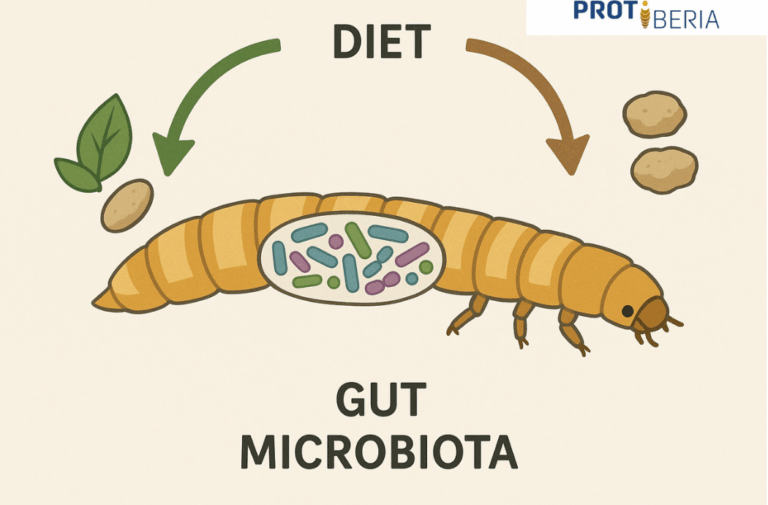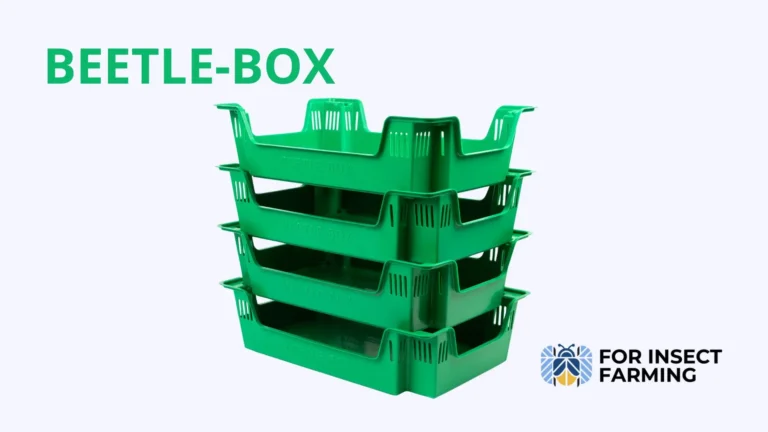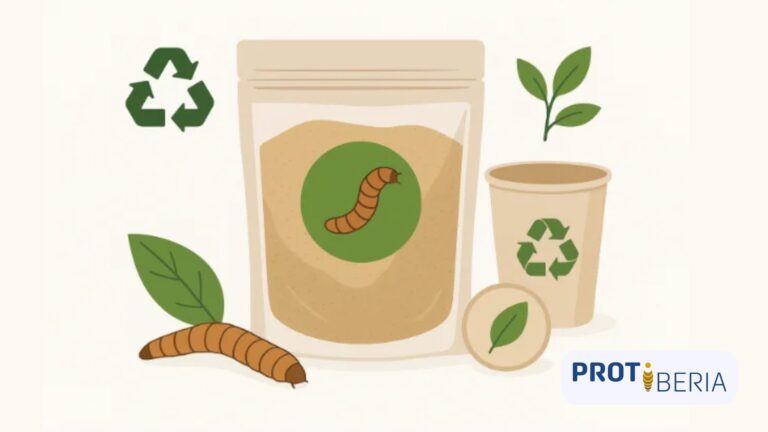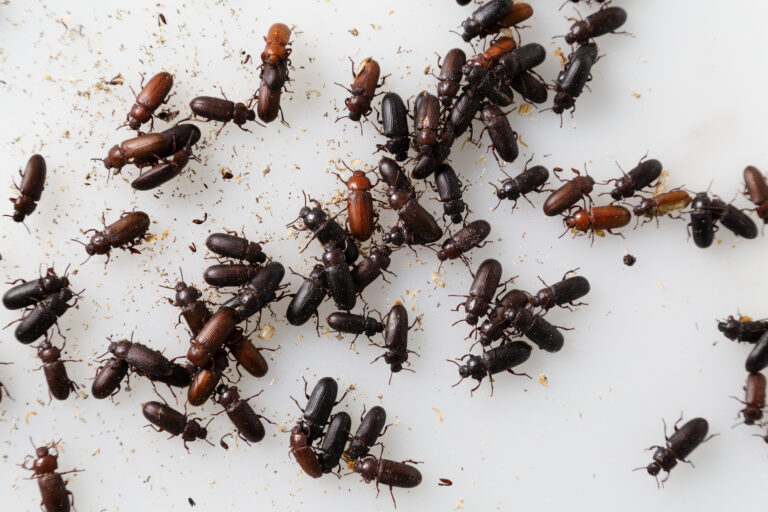| Tenebrio molitor is able to take advantage of agri-food by-products thanks to its gut microbiota. Many bacteria manage to optimize their growth by producing beneficial compounds. This makes it a sustainable solution for converting by-products into high quality protein for animal and human feed. |
In a world where sustainability and circular economy are top priorities, bugs have emerged as a promising alternative source of protein for human and animal nutrition. Among them, Tenebrio molitor, commonly known as the yellow mealworm, stands out for its ability to grow in various types of substrates, including by-products from the agri-food industry.
But what happens in the gut of these tiny organisms when they feed on these by-products?
The answer lies in their gut microbiota, an ecosystem of microorganisms that plays a key role in their digestion, growth, and even their nutritional value. In this article, we’ll explore how the gut microbiota of Tenebrio molitor allows it to exploit agricultural waste, the benefits of this symbiotic relationship, and future applications that could revolutionize the food industry and waste management.
What is the gut microbiota and why is it important?
The gut microbiota is the collection of bacteria and other microbes that live in the digestive system of living beings. In the case of Tenebrio molitor, these microbes help break down difficult-to-digest foods, such as plant fibers, and contribute to its growth and health.
A promising study analyzed how different diets based on agro-industrial by-products affect the microbiota of this species and the results were shocking, the diet not only influences the worms’ growth but also the composition of their microbiota.
Tenebrio molitor and Its Versatile Diet
As previously mentioned, Tenebrio molitor can grow on a wide variety of substrates, from cereals such as wheat and barley to less conventional by-products including fruits, vegetables and even brewery waste. Incredible, isn’t it?
This dietary flexibility is largely due to its gut microbiota, which acts as a specialized “processing system” for breaking down complex materials.
For example, when fed fiber-rich by-products such as wheat bran, its gut microbiota, dominated by bacteria from the phyla Proteobacteria, Firmicutes, and Actinobacteria, helps break down cellulose and other polysaccharides that the insect would be unable to digest on its own. This not only optimizes its growth but also enriches its nutritional value, increasing its protein and healthy fatty acid content.

The Microbiota as a Nutrient Factory
The gut microorganisms of Tenebrio molitor not only break down food but also synthesize essential nutrients.
Recent studies have shown that certain bacteria such as Bacillus can produce or are capable of producing enzymes that degrade fiber and protein, converting waste into energy and useful biomolecules for the larvae, and increase the accumulation of unsaturated fatty acids in the larvae. Furthermore, these bacteria produce antimicrobial compounds that protect the bugs from pathogens.
A clear example is the use of probiotics in the diet of mealworms. When beneficial bacteria such as Pediococcus pentosaceus are added to the substrate, an increased growth and nutrient conversion are observed, suggesting that manipulating their microbiota could be a strategy to optimize their production.

Benefits of Microbiota: Beyond Digestion
The gut microbiota of Tenebrio molitor not only facilitates digestion, but also plays crucial roles in:
- Detoxification: Some intestinal bacteria can degrade contaminants such as mycotoxins or pesticides present in agricultural waste, reducing health risks.
- Protection against pathogens: They compete with harmful bacteria, preventing infections and ensuring a healthy intestinal environment.
- Nutrient synthesis: They produce essential vitamins and amino acids that complement the insect’s diet.
- Biofertilizer: Tenebrio’s frass is a great natural fertilizer that also provides beneficial microorganisms to the soil.
A prominent study showed that Tenebrio molitor larvae fed on mycotoxin-contaminated fungal waste did not accumulate these toxins in their tissues, suggesting an active role of microbiota in detoxification.

Applications in Circular Economy
The ability of Tenebrio molitor to process agro-food waste has profound implications:
- Reduces the amount of waste ending up in landfills.
- Bioremediation: could be used to clean up waste contaminated with pesticides or pharmaceuticals.
- Generates protein-rich biomass that can be used as animal feed (fish, poultry, or pigs) or even in human products, such as baking powder or snacks.
A study revealed that larvae fed on brewing by-products accumulate more omega-3 fatty acids, a valuable nutrient for cardiovascular health. This makes it a “natural bioreactor” that transforms waste into high-value resources.
Conclusion
Tenebrio molitor and its gut microbiota are a fascinating example of how nature can inspire solutions to global challenges. By understanding and leveraging this symbiotic relationship, we are not only moving toward more sustainable food production but also closing the agro-industrial waste cycle.
Still, some questions remain unanswered: How do different by-products affect the composition of the microbiota? Can we design specific diets to obtain insects with personalized nutritional profiles? Research in this field is booming, and each discovery brings us closer to a future where insects play a central role in food and waste management.
In the meantime, the next time you see a mealworm, remember that in its gut, a microscopic universe is working to turn what others discard into something valuable. Nature, once again, teaches us that greatness can be found in small things.
At Protiberia we support R&D advancements to offer healthy, high-quality colonies, highlighting insect farming while creating synergies with other farms, presenting it as an alternative for human consumption.
Referencias
Mannaa, M., Mansour, A., Park, I., Lee, D.-W., & Seo, Y.-S. (2024). Insect-based agri-food waste valorization: Agricultural applications and roles of insect gut microbiota. Environmental Science and Ecotechnology, 17, 100287. https://doi.org/10.1016/j.ese.2023.100287
Montalbán, A., Sánchez, C. J., Hernández, F., Schiavone, A., Madrid, J., & Martínez-Miró, S. (2022). Effects of Agro-Industrial Byproduct-Based Diets on the Growth Performance, Digestibility, Nutritional and Microbiota Composition of Mealworm (Tenebrio molitor L.). Insects, 13(4), 323. https://doi.org/10.3390/insects13040323
Syahrulawal, L., Torske, M. O., Sapkota, R., Næss, G., & Khanal, P. (2023). Improving the nutritional values of yellow mealworm Tenebrio molitor (Coleoptera: Tenebrionidae) larvae as an animal feed ingredient: a review. Journal of Animal Science and Biotechnology, 14(1), 146. https://doi.org/10.1186/s40104-023-00945-x



